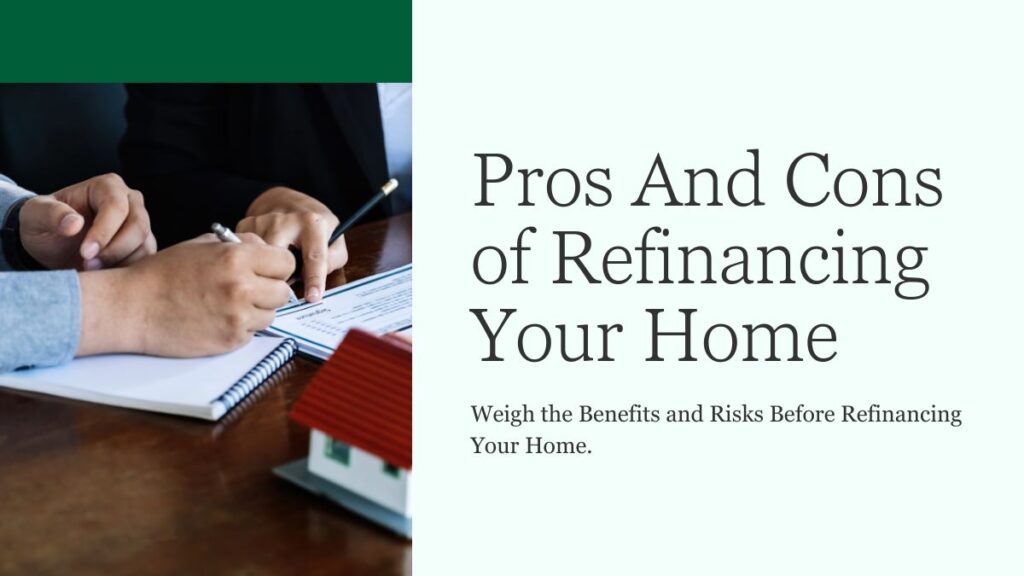A mortgage is like a road trip. You start with one route, but over time, a better path might open up. That’s what refinancing is. It lets you replace your current loan with a new one that fits your needs better, and a residential mortgage broker can help you find the right option.
People refinance to lower their payments, get a better interest rate, or access their home’s value. With changing rates and easy online tools, more homeowners are considering it. But is it the right move for you? Let’s look at the pros and cons of refinancing your home to help you decide.
What is Home Refinancing?
Refinancing means replacing your current mortgage with a new one, usually to get a lower interest rate, change your loan term, or take cash out of your home’s equity. It’s a way to adjust your loan to better fit your needs.
How It Works?
Refinancing is similar to getting a mortgage. Here’s how it goes:
Review your current loan: Check your interest rate, balance, and terms.
Look for better options: Compare new loans with lower rates or better terms.
Apply for refinancing: Submit financial documents like income and credit history.
Home appraisal (if needed): Lenders may check your home’s value.
Approval and closing: If approved, you sign the new loan, and your old one is paid off.
Types of Refinancing
Wondering if refinancing is right for you? Discover the different types of refinancing options that could help you save money or reach your financial goals.
Rate-and-Term Refinancing
This type helps you:
Cash-Out Refinancing
With this option, you borrow more than you owe on your home and take the extra cash for:
Each option has its benefits, depending on your goals.
Pros and Cons of Refinancing Your Home
Is refinancing your home the right move? Weigh the pros and cons to see if it’s the best choice for your financial future.
Pros of Refinancing Your Home
Refinancing can save you money and provide more financial flexibility. Here’s how:
Lower Monthly Payments & Long-Term Savings
Refinancing can lower your interest rate, which means lower monthly payments and less money spent on interest. You can choose:
It’s good to know the break-even point, which is how long it takes for your savings to cover the closing costs. If you stay in your home longer than that, refinancing could be a good idea.
Access to Home Equity
If your home’s value has gone up, you can refinance for a larger loan and take out the extra cash. This is called cash-out refinancing and can be used for:
Debt Consolidation & Loan Term Adjustments
Refinancing can help you roll high-interest debt (like credit cards) into your mortgage, making payments easier and lowering your interest rate.
You can also change your loan terms:
Improved Financial Flexibility
Refinancing lets you adjust your loan to fit your current financial needs, whether that’s freeing up cash or lowering your payment.
Opportunity to Remove Private Mortgage Insurance (PMI)
If your home’s value has increased and you’ve built enough equity, refinancing might help you remove Private Mortgage Insurance (PMI), lowering your monthly payment.
Better Loan Features
Refinancing can give you a mortgage with better terms, like no prepayment penalties, which means you can pay off your loan faster without extra fees.
Refinancing can be a helpful tool, but it depends on your goals and financial situation.
Cons of Refinancing Your Home
Refinancing can help in many ways, but it also has some downsides. Here’s what to keep in mind:
Upfront Costs and Fees
Refinancing isn’t free. You may need to pay for:
Some loans also have extra charges, like prepayment penalties or fees for breaking your mortgage early. Always check for hidden costs.
Longer Loan Term & More Debt Risks
If you refinance into a new 30-year loan, you might lower your monthly payment. However, you could end up paying more over time because you’ll be paying for a longer period and could pay more in interest.
Effects on Home Equity & Credit Score
A cash-out refinance gives you extra money, but it lowers your home equity. If home values drop, you might owe more than your home is worth.
Refinancing also involves a hard credit check, which can lower your credit score slightly. Taking on new debt can affect your credit as well.
Potential to Reset Your Loan Progress
If you refinance after having your mortgage for a while, you might reset the clock on paying off your loan. This means you’ll lose progress on paying down your principal balance and extend the time before your home is paid off.
Risk of Over-Borrowing
With a cash-out refinance, you might be tempted to borrow more than you need. This could lead to more debt and higher monthly payments, putting a strain on your finances in the long run.
Not Always Possible with Low Equity
If you don’t have enough equity in your home, you may not be able to refinance or may face higher interest rates. In some cases, refinancing may not even be an option if your home’s value has decreased significantly.
Before refinancing, consider the costs and risks to see if it’s truly the right move for you.
Why Homeowners Consider Refinancing?
Homeowners refinance for a variety of reasons, and it can help improve their financial situation. Here’s why people refinance:
Lower Payments
Refinancing can get you a lower interest rate, which means smaller monthly payments. This can save you money or give you more breathing room in your budget.
Lower interest rates = lower payments.
Longer loan terms can also lower payments, but you might pay more over time.
Access Home Equity
If your home is worth more now, refinancing lets you borrow more and take out cash. You can use it for:
Just remember, using your home’s value lowers how much you own in it.
Change Loan Terms
Refinancing allows you to change the length of your loan:
Shorter loan term: If you want to pay off your home faster, you can go for a shorter loan term.
Longer loan term: If you need lower monthly payments, a longer loan term can help.
Consolidate Debt
Refinancing can help you combine high-interest debt (like credit cards) into your mortgage, which may lower your interest rate and make payments easier.
Remove Private Mortgage Insurance (PMI)
If your home’s value has gone up and you’ve built enough equity, refinancing can help you get rid of PMI. This could lower your monthly payments.
Take Advantage of Better Loan Features
Refinancing can also help you switch to a loan with better features, like no prepayment penalties. This means you can pay off your mortgage faster without extra fees.
Switch to a Fixed-Rate Mortgage
If you have an adjustable-rate mortgage (ARM), refinancing to a fixed-rate mortgage can give you stable payments since your rate won’t change.
Refinancing can be a helpful option, but it’s important to think about your goals and needs before deciding.
Current Trends in Refinancing
efinancing in Canada is changing as the economy shifts. Here’s what’s happening:
Lower Payments
With lower interest rates, some homeowners can refinance to pay less each month. But many are waiting to see if rates will drop more.
Access Home Equity
Homeowners are using their home’s value to borrow more money. This extra cash is often used for things like home repairs, paying off debt, or covering big expenses. But borrowing more means owning less of your home.
Change Loan Terms
Some people are refinancing to change how long they’ll pay off their mortgage. Shorter terms help pay off the loan faster, while longer terms can lower monthly payments.
Refinancing is still a good option for some, but it’s important to think about the long term and the economy before making any decisions.
How to Decide if Refinancing Is Right for You?
Thinking about a mortgage refinance Canada? Before you take the plunge, make sure it’s the right move for your finances. Here’s how to determine if refinancing fits your goals and helps you save.
Evaluate Your Financial Goals
What do you want to achieve: Lower monthly payments, pay off your loan faster, or free up cash for other expenses
How long will you stay in your home: If you’re planning to move soon, the upfront costs might not be worth it
Check Market Conditions & Interest Rates
Compare current rates: Look at your current interest rate and see if refinancing offers a lower rate
Break-even point: Use a refinance calculator to find out when your savings will cover the costs. If you plan to stay past that point, refinancing could be a good choice
Review Your Financial Health
Credit Score & Eligibility: Check your score first since lenders usually have minimum requirements
Use Refinance Calculators: These tools help you estimate your potential savings and determine your break-even point
Consider the Costs of Refinancing
Upfront Fees: Be aware of closing costs and other fees like application or appraisal fees
Loan Term Adjustment: Refinancing might extend your loan term, which can lower your monthly payments but may increase the total interest you pay over time
Consult a Financial Advisor
Professional Advice: A financial advisor can review your situation and help you decide if refinancing fits your long-term goals
This simple guide should help you weigh the pros and cons of refinancing in a natural, easy-to-understand way.
The Refinancing Process
Refinancing your home involves several important steps. Here’s a simple breakdown:
Steps to Get Started
Research Lenders: Compare different lenders to find the best deal.
Check Your Finances: Know your credit score and loan details.
Gather Documents: Collect income proof, tax returns, and mortgage info.
Know Your Loan Options: Understand available loan types.
Set a Goal: Know what you want to achieve with refinancing.
Process Phases
Application: Submit necessary paperwork to the lender.
Underwriting: The lender reviews your finances and credit history.
Appraisal: The lender may assess your home’s value.
Closing: Sign the final paperwork and complete the process.
Post-Closing: Track new loan terms and adjust your budget.
Tips & Common Mistakes
Avoid costly missteps with these simple tips and tricks to ensure a smooth refinancing process!
Do
Don’t
Alternatives to Traditional Refinancing
If traditional refinancing doesn’t seem like the best fit, here are some other options:
Home Equity Options
Unlock the value of your home with smart equity options, discover how you can tap into your home’s potential for cash, improvements, or debt relief!
HELOC vs. Cash-Out Refinance
HELOC (Home Equity Line of Credit): Works like a credit card, allowing you to borrow from your home’s equity as needed. You only pay interest on what you borrow.
Cash-Out Refinance: Replaces your mortgage with a larger loan, giving you a lump sum of cash. This option may be helpful if you need a larger amount of money at once.
Other Options
Explore other options to manage your finances. Whether it’s consolidating debt or finding flexible solutions, there’s a strategy that fits your needs.
Loan Modification or Blend-and-Extend
You may be able to work with your current lender to adjust your loan terms, like lowering your interest rate or extending your loan term, without refinancing.
Second Mortgage & Mortgage Recasting:
Second Mortgage: Adds another loan on top of your current one, giving you extra cash. This option could be useful for things like home improvements.
Mortgage Recasting: Lets you lower your monthly payments by making a large extra payment toward your loan balance. It doesn’t require refinancing, but you need enough savings for a lump-sum payment.
Each option has its own benefits and drawbacks. Consider your financial needs and goals to decide which one might be the best choice for you.
Future Considerations: Market Trends & Economic Factors
Before refinancing, think about how market changes could affect your decision.
Interest Rates
Rates go up and down, which affects how much you can save.
If rates are low, it may be a good time to refinance.
If rates are rising, locking in a lower rate sooner could help.
Market changes can also affect loan options and lender rules.
Housing Market
Home values change, which affects how much equity you can use.
If prices drop, you could owe more than your home is worth.
A strong market can mean better loan options and higher home appraisals.
Local trends matter, check your area before making a decision.
Watching these trends can help you decide if refinancing is right for you.
Real-Life Stories: Wins & Mistakes
Refinancing can be a great move or a costly mistake. Here are real examples:
Success Story: Paying Off the Loan Faster
John switched from a 30-year mortgage to a 15-year loan with a lower interest rate. His monthly payment went up a little, but he saved thousands in interest and will own his home much sooner.
Mistake: Cash-Out Refinance Trouble
Lisa refinanced to take cash out for home upgrades and to pay off debt. But later, she struggled with higher mortgage payments and ended up in more debt.
What We Can Learn
By learning from others, you can avoid mistakes and make a smart choice.
Conclusion: Is Refinancing Your Home Worth It?
Refinancing can help you save money or make things easier, but it’s not for everyone. Think about your finances and goals to see if it’s the right choice for you. Is it worth it? Let’s find out.
Recap of Pros & Cons
Refinancing can save money or offer flexibility, but it may have fees. Other options like HELOCs or second mortgages have their own risks. Weigh the pros and cons to find what works best.
Pros
Cons
Final Considerations
Before deciding, run a break-even analysis to see if refinancing will save you money in the long run. Talking to a financial advisor can also help you weigh your options.
What to do Next?
Take a close look at your financial situation and current market conditions. If refinancing aligns with your long-term goals, it could be a great way to improve your financial future with the best mortgage solutions.
FAQs About Home Refinancing
When should I refinance?
Refinance if interest rates are lower than what you’re paying now, your credit is good, and you plan to stay in your home long enough to make it worth the cost.
How much does refinancing cost?
It usually costs 2–6% of your loan amount in fees. Make sure you’ll save more than you spend.
Will refinancing lower my credit score?
It might drop a little at first because of a credit check and new loan. But if you make payments on time, your score should bounce back.
Can I refinance if my home’s value has dropped?
It can be harder, but some loan programs, like FHA or VA refinance options, might still work.
What’s the difference between a cash-out refinance and a HELOC?
Cash-out refinance: You get a lump sum of cash by replacing your mortgage with a bigger one.
HELOC: A credit line that lets you borrow as needed.


